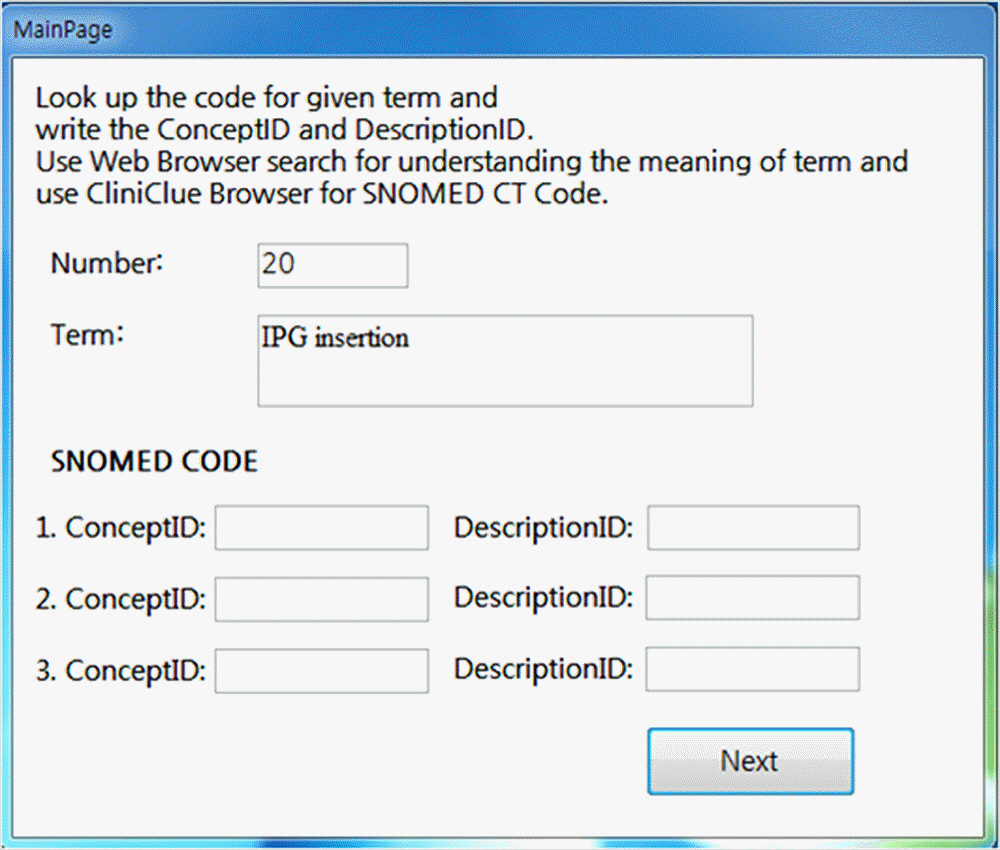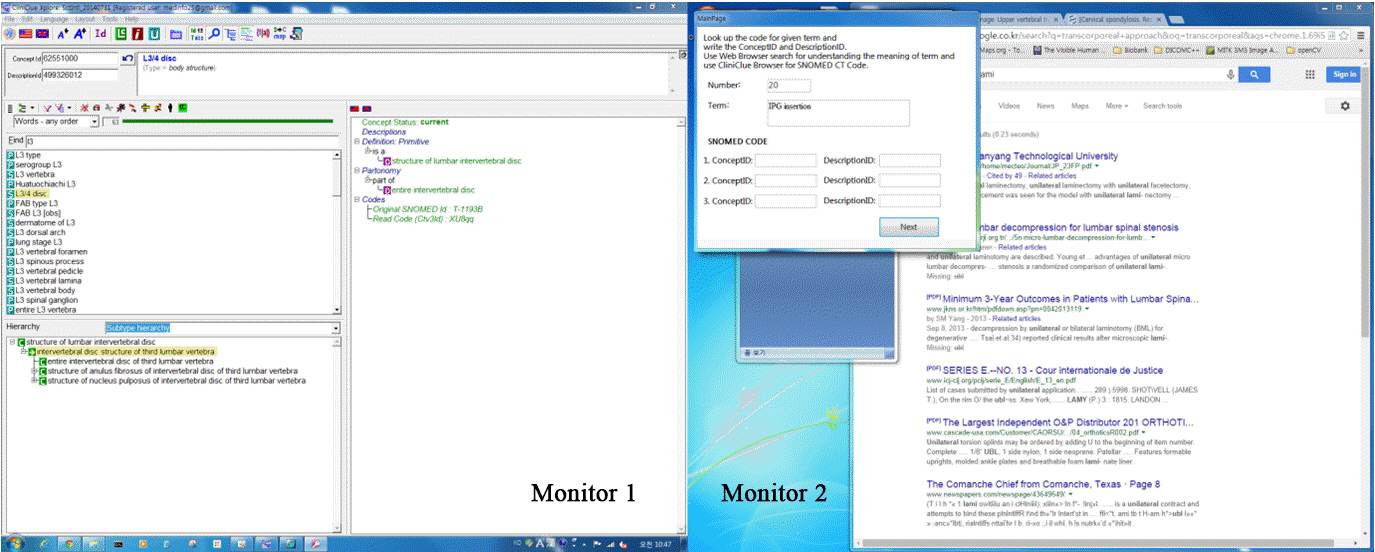Yeungnam Univ J Med.
2019 Sep;36(3):225-230. 10.12701/yujm.2019.00220.
Computer-based clinical coding activity analysis for neurosurgical terms
- Affiliations
-
- 1Convergence Medical Institute of Technology, Pusan National University Hospital, Busan, Korea.
- 2Department of Neurosurgery, Pusan National University Hospital, Busan, Korea. medi98@hanmail.net
- 3Department of Healthcare Information Management, Catholic University of Pusan, Busan, Korea.
- KMID: 2460191
- DOI: http://doi.org/10.12701/yujm.2019.00220
Abstract
- BACKGROUND
It is not possible to measure how much activity is required to understand and code a medical data. We introduce an assessment method in clinical coding, and applied this method to neurosurgical terms.
METHODS
Coding activity consists of two stages. At first, the coders need to understand a presented medical term (informational activity). The second coding stage is about a navigating terminology browser to find a code that matches the concept (code-matching activity). Systematized Nomenclature of Medicine - Clinical Terms (SNOMED CT) was used for the coding system. A new computer application to record the trajectory of the computer mouse and record the usage time was programmed. Using this application, we measured the time that was spent. A senior neurosurgeon who has studied SNOMED CT has analyzed the accuracy of the input coding. This method was tested by five neurosurgical residents (NSRs) and five medical record administrators (MRAs), and 20 neurosurgical terms were used.
RESULTS
The mean accuracy of the NSR group was 89.33%, and the mean accuracy of the MRA group was 80% (p=0.024). The mean duration for total coding of the NSR group was 158.47 seconds, and the mean duration for total coding of the MRA group was 271.75 seconds (p=0.003).
CONCLUSION
We proposed a method to analyze the clinical coding process. Through this method, it was possible to accurately calculate the time required for the coding. In neurosurgical terms, NSRs had shorter time to complete the coding and higher accuracy than MRAs.
MeSH Terms
Figure
Reference
-
References
1. Nishimura A, Nishimura K, Kada A, Iihara K; J-ASPECT Study GROUP. Status and future perspectives of utilizing big data in neurosurgical and stroke research. Neurol Med Chir (Tokyo). 2016; 56:655–63.
Article2. Yoon D, Ahn EK, Park MY, Cho SY, Ryan P, Schuemie MJ, et al. Conversion and data quality assessment of electronic health record data at a Korean tertiary teaching hospital to a common data model for distributed network research. Healthc Inform Res. 2016; 22:54–8.
Article3. Popovic JR. Distributed data networks: a blueprint for Big Data sharing and healthcare analytics. Ann N Y Acad Sci. 2017; 1387:105–11.
Article4. Carter KJ, Rinehart S, Kessler E, Caccamo LP, Ritchey NP, Erickson BA, et al. Quality assurance in anatomic pathology: automated SNOMED coding. J Am Med Inform Assoc. 1996; 3:270–2.
Article5. Wasserman H, Wang J. An applied evaluation of SNOMED CT as a clinical vocabulary for the computerized diagnosis and problem list. AMIA Annu Symp Proc. 2003:699–703.6. Haliasos N, Rezajooi K, O'neill KS, Van Dellen J, Hudovsky A, Nouraei S. Financial and clinical governance implications of clinical coding accuracy in neurosurgery: a multidisciplinary audit. Br J Neurosurg. 2010; 24:191–5.
Article7. Yoon D, Chang BC, Kang SW, Bae H, Park RW. Adoption of electronic health records in Korean tertiary teaching and general hospitals. Int J Med Inform. 2012; 81:196–203.
Article8. Lee D, de Keizer N, Lau F, Cornet R. Literature review of SNOMED CT use. J Am Med Inform Assoc. 2014; 21:e11–9.
Article9. Sohn S, Kim J, Chung CK, Lee NR, Sohn MJ, Kim SH. A nation-wide epidemiological study of newly diagnosed primary spine tumor in the adult Korean population, 2009-2011. J Korean Neurosurg Soc. 2017; 60:195–204.
Article10. Choi BK, Han IH, Cho WH, Cha SH. Inferiorly migrated disc fragment at t1 body treated by t1 transcorporeal approach. J Korean Neurosurg Soc. 2011; 49:61–4.
Article11. de Lusignan S. The barriers to clinical coding in general practice: a literature review. Med Inform Internet Med. 2005; 30:89–97.
Article
- Full Text Links
- Actions
-
Cited
- CITED
-
- Close
- Share
- Similar articles
-
- Computerization of Patient Data Management for Vology by Automatic Coding System : A Program Using dBASE IV in Personal Computer
- Hot to Manage and Use the Clinical Data with Personal computer
- The Design of Wavelet-based Biological Signal CODEC for Telemedicine Application
- Computerization of 100,000 cases of Surgical Pathology Data at SNUH by Automatic Coding System using Personal Computer
- 3-D Lossless Volumetric Medical Image Compression Using 3-D Integer Wavelet Transform and Lifting Steps



